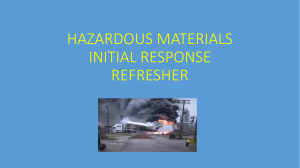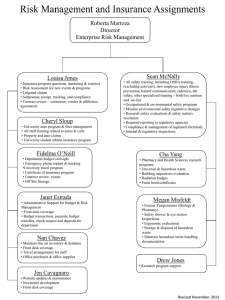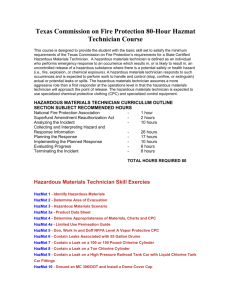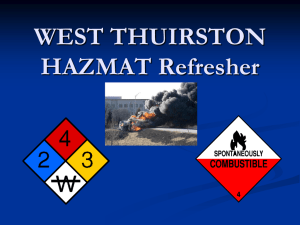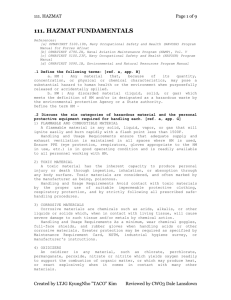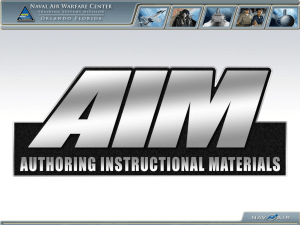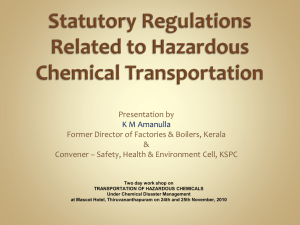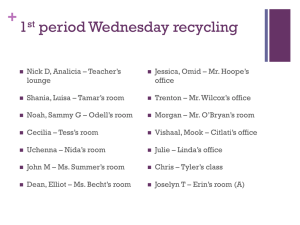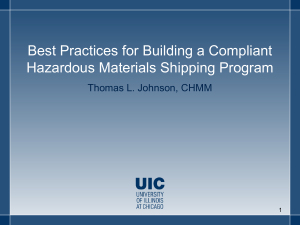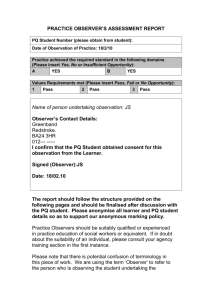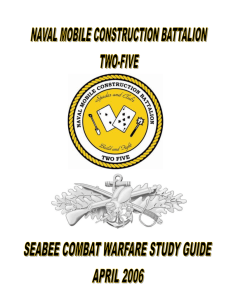PPT: Common Core 105 Hazmat
advertisement
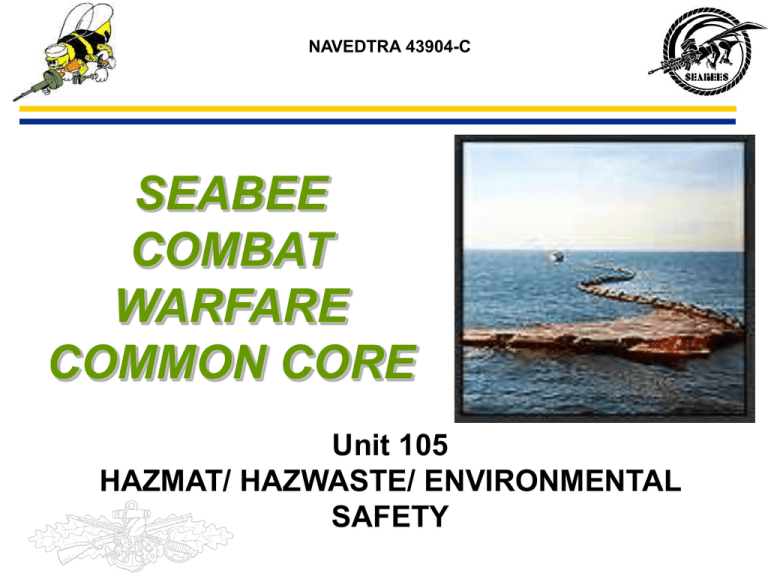
NAVEDTRA 43904-C SEABEE COMBAT WARFARE COMMON CORE Unit 105 HAZMAT/ HAZWASTE/ ENVIRONMENTAL SAFETY References - OPNAVINST 5100.23G Navy Occupational Safety and Health (NAVOSH) Program Manual NAVEDTRA 14233 Navy Construction Force/ Seabee 1&C NAVEDTRA 14167 Naval Safety Supervisor OPNAVINST 5100.19D Naval Occupational Safety and Health (NAVOSH) Program Manual for Forces Afloat COMFIRSTNCDINST 5100.2B, Naval Construction Force Occupational Safety and Health Program Manual OPNAVINST 5090.1B, CH-4, Environmental and Natural Resource Program Manual 29 CFR Part 1910 General Industry Standards HAZMAT/ HAZWASTE • PQS Question 105.1 Describe the difference between Hazardous Material (HAZMAT) and Hazardous Waste (HW) • Reference: NAVEDTRA 14167 [ch. 5, pp. 5-7 thru 5-9] HAZMAT/ HAZWASTE HAZARDOUS MATERIAL is a material that is harmful to the environment such as paint, cleaners, acids, glues, or other flammables. HAZWASTE is a product generated from a process that once completed, the product can no longer be used to meet it’s original intended purpose. HAZMAT which has exceeded it’s shelf-life is considered HAZWASTE also. Material Safety Data Sheet (MSDS) • PQS Question 105.2 State the purpose and information contained on the Material Safety Data Sheet (MSDS) • Reference: NAVEDTRA 14233 [ch. 7] NAVEDTRA 14167 [ch. 5] Material Safety Data Sheet (MSDS) • A document generated by the manufacturer of the material that communicates to the users the chemical, physical, and hazardous properties of that material. • In Compliance with OSHA hazard communication, standard key information includes: - Name, address, and emergency contact for the manufacturer. - Physical and Chemical Characteristics. - Fire and Explosive Hazard Data. - Reactivity Data. - Health Hazard Data. - Precautions for Safe Handling and Use. - Control Measures. HAZMAT Hazard Categories • PQS Question 105.3 What are the six categories of HAZMAT • Reference: NAVEDTRA 14167 [ch. 5, p. 5-7] 6 Types of HAZMAT • • • • • • 1: Flammables and Combustibles (fuels/grease) 2: Aerosols 3: Toxins and Poisonous materials 4: Compressed gases ( acetylene/ oxygen) 5: Oxidizers (bleach/ calcium hypochloride) 6: Corrosives (acids or alkali's) Storage Procedures • PQS Question 105.4 Explain the storage procedures for incompatible materials. • Reference: OPNAVINST 5100.19D [ch. C23-4 thru C23-7, appendix. C23-F] Storage Procedures • According to the type of HAZMAT, certain storage procedures must be applied. For example, do not mix flammable and toxic materials, or flammables and corrosives together. • The safest practice concerning hazardous material is to draw only the amount of material that can be used that day. Storing hazardous materials on the job site requires the use of approved containers. These containers must be placed a minimum of 50 feet away from any ignition device or source. Plan for the delivery of proper storage equipment before having hazardous materials delivered to the job site. Storage Procedures Spills • PQS Question 105.5 Explain the general procedures to be followed when a Hazardous Material/ Hazardous Waste (HM/HW) spill is discovered. • Reference: OPNAVINST 5090.1B CH-4 [ch. 10, pp. 10-10 thru 10-19] 29 CFR Part 1910 [CFR 1910.120] Spills • HAZMAT / HAZWASTE spills: - The unit must respond immediately with an approved response team, equipment, and disposal plan. Reports must be made and tests conducted to ensure no contamination remains. Disposal of contaminate soils, etc. must follow strict guidelines. HAZMAT PPE • PQS Question 105.6 State the PPE required when handling HM/HM at levels A, B, C, D. • Reference: 29 CFR Part 1910 • [29 CFR 1910.120, app. B] HAZMAT PPE • Personal Protective Equipment (PPE): Ensure all personnel understand the following. - What hazard materials are present. - What dangers they present when exposed to personnel and equipment. - What PPE is required for protection from each specific danger. - What training is required for proper use of PPE. - Ensure proper training is documented. - Ensure training includes the issue, use, and maintenance of PPE in routine and non-routine use of hazardous materials. - Ensure comprehensive risk assessments are conducted at all job sites and work areas. Classification Codes • PQS Question 105.7 What are the 9 different Hazard Classification codes? Classification Codes • Class 1: Explosives Classification Codes • Class 2: Gases Classification Codes • Class 3: Flammable Liquids Classification Codes • Class 4: Flammable Solids Classification Codes • Class 5: Oxidizing Agents and Organic Peroxides Classification Codes • Class 6: Toxic and Infections Substances Classification Codes • Class 7: Radioactive Substances Classification Codes • Class 8: Corrosive Substances Classification Codes • Class 9: Miscellaneous Secondary Labeling • PQS Question 105.8 Describe the purpose of secondary labeling of HAZMAT when removed from the original container. • Reference: NAVEDTRA 14233 [Ch. 7] Secondary Labeling • Labeling and marking of containers: The name of the manufacturer and the organization receiving, sending, using, or transferring the material to other containers. • Example. A two quart can filled with oil from the lube rack must have a label on it specifying what type of HM is in the can, the name of the manufacturer, and nature of the hazard. • Identify reference sources for use in verifying label and marking requirements and provide recommendations, training guidelines, and procedures for labeling and marking all containers including tanks, pipes, and secondary containers. • Provide consultation on the identification of HM, the labeling and marking of HM containers for special applications or conditions of use, and for HM produced or manufactured locally by the activity. Secondary Labeling Terminology • PQS Question 105.9 Define the following terms: • Hazardous Material Minimization Center [OPNAVINST 5100.19D, Ch. C2303] • Consolidated Hazardous Material Reutilization and Inventory Management Program (CHRIMP) [OPNAVINST 5090.1B, ch. 3] • Hazardous Materials Inventory Control System (HICS) [OPNAVINST 5090.1B, ch. 3] Terminology • HAZMINCEN ( Hazardous Minimization Center): - Issues receives, prepares for disposal, and stores excess stock of HM. • CHRIMP ( Consolidated Hazardous Material Reutilization Inventory Management Program ): - Tracks, bar codes, and creates requisitions for HM. • HICS ( Hazardous Inventory Control System ): - Prepares reports for administration purposes of the HM inventory. A combined program with CHRIMP. - Both CHRIMP and HICS are being replaced with Hazardous Substance Management System (HSMS). This program provides the same functions. Spill Containment • PQS Question 105.10 Discuss the aspects of portable containment of oil spills on water. • Reference: NAVEDTRA 14233 [ch. 7] Spill Containment • Portable containment of oil spills on water: Boom of spills has proven to be an effective method of containing spills of liquids on relatively calm and current free waters. Because of ecological considerations, booming has become an important means of containing oil spills, even though more effective equipment is now available. • Following confinement of oil spills on water, various methods of removing the confined liquids have been used. - Absorbents, such as straw, plastics, sawdust, and peat moss are spread on the surface of the spill and then collected and burned on shore. - Skimming devices operate on a different principle and must include pumps and separators. Skimmers scoop up the oil and water and send them through an oil separator and rollers to which only the oil adheres. The oil is then removed by scraping and compression. Important HAZMAT Items • PQS Question 105.11 Discuss the following: a. Oil spills b. Grubbing operations c. Asbestos d. Polychlorinated Biphenyls (PCB) Reference: NAVEDTRA 14233 [ch. 7] Oil Spills • Small spills in areas with shallow groundwater table or where contained by natural barriers can be immediately remedied. • Interceptor Trench. • Stripping and replacing of contaminated soil. Grubbing Operations • Large scale clearing in initial stages of a project can produce damaging side effects: - Increased soil erosion. - Reduction of atmospheric oxygen. - Destruction of wildlife habitat. • Preventative Measures: - Save as much vegetation as possible. - Construct a shallow trench around the project. - Burn only when necessary. Asbestos • Fibrous material used extensively from the 1930’s to the 1960’s. It is a known carcinogen. Hazardous when airborne and inhaled. Symptoms don’t occur until years later. • Covered by OPNAVINST 5100.23. • As a rule, NCF does NOT do asbestos work. Polychlorinated Biphenyl's (PCB’s) • Group of toxic chemicals used extensively as insulators and coolers in electrical equipment, especially transformers. • Causes irritation to eyes, skin, and lungs, also suspected of causing cancer. • Regulated beginning with the Toxic Substances Control Act in 1977.
